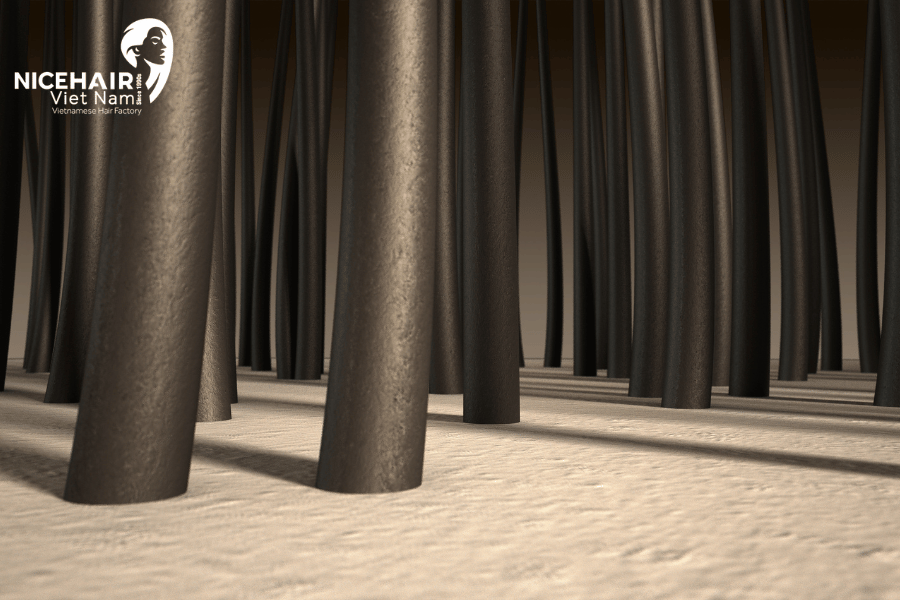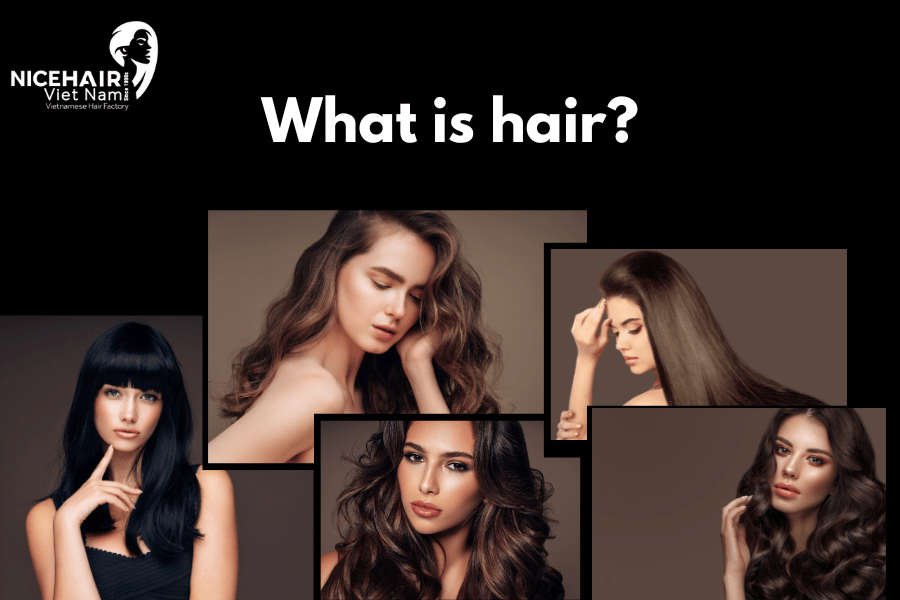Hair is a protein filament that originates from follicles in the dermis, serves as a defining characteristic of mammals. With the exception of smooth skin regions, the human body is extensively covered in follicles that generate both thick terminal hair and fine vellus hair. While there is significant interest in hair growth, types, and care, it is important to recognize that hair also holds great importance as a biomaterial primarily comprising protein, particularly alpha-keratin.
Description
Each individual hair strand consists of three main layers: the medulla, cortex, and cuticle. The innermost layer, known as the medulla, is an unstructured and often absent region. The cortex, situated between the medulla and the outer cuticle, provides mechanical strength and absorbs water. It contains melanin, which determines the hair’s color based on the distribution, quantity, and type of melanin granules. These granules may be evenly spaced or concentrated along the hair’s edges. The shape of the hair follicle determines the shape of the cortex, and consequently, the straightness or curliness of the hair. Straight hair typically has round fibers, while oval or other-shaped fibers tend to result in wavy or curly hair. The cuticle forms the outermost layer, featuring a complex structure that moves as the hair expands and contracts. A single molecular layer of lipid covers the cuticle, providing water-repelling properties.

The diameter of human hair varies from 0.017 to 0.18 millimeters. Some characteristics of head hair differ by racial background. Individuals of African ancestry typically have hair with a diameter of 60-90 μm and a flat cross-section, while those of European or Middle Eastern descent tend to have hair with a diameter of 70-100 μm and an oval cross-section. People of Asian or Native American heritage commonly have hair with a diameter of 90-120 μm and a round cross-section. There are approximately two million small tubular glands and sweat glands in the scalp that produce watery fluids to cool the body through evaporation. The glands near the hair opening produce an oily substance that lubricates the hair.
Hair growth begins within the hair follicle, with the only living portion located in this structure. The visible part of the hair, known as the hair shaft, is considered “dead” as it lacks biochemical activity. The base of the hair’s root, known as the bulb, contains the cells responsible for producing the hair shaft. Other components of the hair follicle include the sebaceous gland, which produces oil to lubricate the hair, and the arrector pili muscles, which contract and cause the hair to stand up. In humans with minimal body hair, this muscle contraction results in goosebumps.
Root of the hair
At the base of each hair, there is a bulb that serves as the root. This bulb is larger in size and has a whiter color and softer texture compared to the hair shaft. It is nestled within a structure called the hair follicle, which is a fold of the epidermis. The hair bulb is comprised of various components, including fibrous connective tissue, a glassy membrane, an external root sheath, and an internal root sheath. The internal root sheath consists of two layers: the epithelium stratum (also known as Henle’s layer) and the granular stratum (referred to as Huxley’s layer). Additionally, the bulb contains the cuticle, cortex, and medulla, which are layers found in the hair shaft.

Natural color
All natural hair colors are determined by two types of hair pigments. These pigments, known as melanin, are produced within the hair follicle and stored in granules within the hair fibers. The dominant pigment in brown and black hair is eumelanin, while red hair is primarily influenced by the presence of pheomelanin. Blonde hair, on the other hand, is characterized by a lower concentration of pigmentation in the hair strands. Gray hair occurs when there is a decrease or complete halt in melanin production, while poliosis refers to white hair (and often the corresponding skin) appearing in specific areas that never had melanin or ceased producing it naturally, typically due to genetic factors during early childhood.

Human hair growth
Hair grows across the entire external body except for mucus membranes and glabrous skin areas, such as the palms of the hands, soles of the feet, and lips.
The growth of hair follows a specific cycle that consists of three distinct and concurrent phases: anagen, catagen, and telogen. These phases occur simultaneously throughout the body and each phase has its own characteristics that determine the length of the hair.
The body possesses various types of hair, including vellus hair and androgenic hair, each having its own cellular structure. These different structures give the hair its unique characteristics, serving specific purposes, primarily providing warmth and protection.
Texture
Hair comes in a diverse range of textures, characterized by three main aspects: curl pattern, volume, and consistency. The composition of all mammalian hair is keratin, meaning that variations in hair patterns are not attributed to the structure of hair follicles. Multiple theories exist regarding the curl patterns of hair, with scientists suggesting that the shape of the hair shaft influences the individual’s hair curliness. A round shaft with fewer disulfide bonds typically results in straight hair, while a flatter shaft allows more cysteines to compact together, resulting in a bent shape and increasing curliness. The curl pattern is determined by the shape of the hair follicle, while follicle size determines hair thickness, ranging from thin to normal to thick.

Hair consistency can be classified into three categories: fine, medium, and coarse, which is influenced by the volume of the hair follicle and the condition of the strand. Fine hair has a smaller circumference, coarse hair has a larger circumference, and medium hair falls in between. Coarse hair tends to have a more open cuticle, making it more porous compared to thin or medium hair.
There are various classification systems used to categorize hair types, aiding in understanding how to care for one’s hair. The Andre Walker Hair Typing System, created by Oprah Winfrey’s hairstylist, is a widely utilized system. It classifies hair into four types: straight, wavy, curly, and kinky. Straight hair is resilient, reflecting high sheen and being difficult to curl. Wavy hair falls between straight and curly, with varying levels of frizziness. Curly hair exhibits an S-shaped curl pattern, while kinky hair has tightly coiled or no discernible curl pattern. Kinky hair is often fragile and dense, prone to shrinkage when wet and more susceptible to damage due to fewer cuticle layers.
It’s important to note that individuals may have more than one hair type and can have a combination of different curl patterns. Understanding one’s hair type can serve as a starting point for proper hair care.
Composition
Hair primarily consists of keratin proteins and keratin-associated proteins (KRTAPs). The human genetic blueprint contains instructions for producing 54 distinct keratin proteins, which are present in varying quantities within the hair. Additionally, there are over 100 different KRTAPs encoded in the human genome, which serve to link and stabilize the keratins in the hair structure. The proportion of KRTAPs in hair can range from less than 3% in human hair to as high as 30-40% in echidna quills.
Hair care
Hair care involves a range of measures and practices aimed at maintaining the health, appearance, and manageability of hair. It encompasses various aspects, including cleansing, conditioning, styling, and protecting the hair from damage. Proper hair care routines differ from person to person based on their hair type, texture, and specific needs. Here are some key measures and practices commonly employed in hair care:
- Cleansing: Regularly washing the hair is essential to remove dirt, excess oils, and product buildup. Choosing a suitable shampoo based on hair type (such as dry, oily, or color-treated) can help maintain a balanced scalp and clean hair.
- Conditioning: Conditioning is vital to keep the hair moisturized, nourished, and manageable. Using a conditioner after shampooing helps to detangle hair, improve its softness, and prevent dryness and frizz. Deep conditioning treatments can provide extra hydration and repair damaged hair.
- Protecting from heat and styling: Heat styling tools like flat irons, curling irons, and blow dryers can damage hair if used excessively or without proper protection. Using heat protectant sprays or serums before styling can help minimize damage from heat and maintain the hair’s integrity.
- Trimming: Regular trims every 6-8 weeks can help prevent split ends and promote healthy hair growth. Trimming removes damaged and frayed ends, keeping the hair looking fresh and preventing breakage.
- Moisturizing: Maintaining adequate moisture levels is crucial for preventing dryness, brittleness, and breakage. Applying leave-in conditioners, hair oils, or serums can provide additional hydration and seal in moisture.
- Avoiding harsh chemicals: Harsh chemicals found in certain hair products, such as sulfates and alcohol, can strip the hair of its natural oils and cause dryness. Opting for sulfate-free shampoos, alcohol-free styling products, and gentle hair dyes can help maintain the hair’s health.
- Protecting from environmental factors: Environmental elements like sun exposure, wind, and pollution can cause damage to the hair. Wearing hats or scarves and using UV-protectant hair sprays can shield the hair from harmful UV rays and minimize environmental damage.
- Brushing and detangling: Using a wide-toothed comb or a brush with soft bristles can help prevent hair breakage and minimize tangles. Starting from the ends and gradually working upward when detangling can reduce hair damage.
- Avoiding excessive manipulation: Frequent pulling, tugging, and tight hairstyles like ponytails or braids can cause stress and damage to the hair. Opting for looser hairstyles and avoiding excessive pulling can help maintain hair health.
- Proper nutrition: A balanced diet rich in vitamins, minerals, and proteins contributes to healthy hair growth. Consuming foods like fruits, vegetables, lean proteins, and healthy fats can provide the necessary nutrients for strong and vibrant hair.

It’s important to note that individual hair care needs may vary, and consulting with a professional hairstylist or trichologist can provide personalized guidance and recommendations for effective hair care practices.

